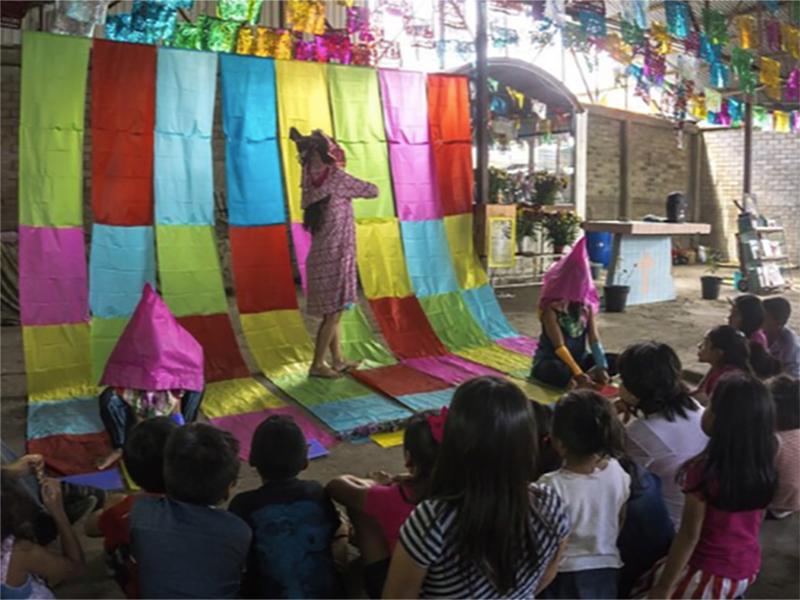Digital exhibition ‘Conexión: Art and Activism in Oaxaca’ showcases work by Latin American Studies students
Since March, Tulane students, staff and faculty have gone above and beyond, adapting their work in real-time to go digital. For many, these challenges have been met with innovative outlets such as the School of Architecture’s recent online thesis show and the School of Liberal Arts’ summer cluster of creative classes.
For students from the spring 2020 course “Women, Community and the Arts in Latin America: Oaxaca, Mexico” co-taught by Edith Wolfe, assistant director of the Roger Thayer Stone Center for Latin American Studies, and Newcomb Art Museum Director Monica Ramirez-Montagut, the crisis created by COVID-19 necessitated a 180-degree shift of the intended outcome of the class.
The class was scheduled to travel to Mexico (through the generous support of the Dorothy Beckemeyer Skau Art and Music Fund at the Newcomb College Institute, Stone Center for Latin American Studies, The Center for Inter-American Policy & Research, the Gender and Sexuality Studies program, the dean’s office at the School of Liberal Arts, the Center for Engaged Learning & Teaching, the Center for Public Service, and Center for Academic Equity) during Tulane’s spring break to meet, interview and work with Oaxacan socially-engaged artists and activists addressing the problems of gender-based violence and discrimination, economic hardship, access to education, family separation and other issues affecting their communities. The result of the trip would then turn into a student-organized art and social history exhibition hosted at the Newcomb Art Museum on campus, complete with engaging programming and activities.
“When COVID-19 necessitated that we cancel our visit to Oaxaca, we again reevaluated our positionality and took our ambitions another step back. Now, our goal is to see whether or not a fair representation is possible at all in our physically-distanced reality. For a moment we questioned if this goal was possible. We feared that the current state of the world had caused our exhibition to crumble. However, we decided that sharing our electronically-mediated affairs could prove more beneficial to the world of Social Practice Art than the original physically-grounded exhibition,” students from the course, Jasmine Gloria, Lucia Paternostro and Gabriella Zimbalist, said.
The outcome of the course is the brand new digital exhibition “Conexión: Art and Activism in Oaxaca.” The exhibition documents how community-based projects in San Francisco de Tanivet and central parts of the city are shifting the narratives of human rights and empowerment, female authorship, immigration and childcare in the workplace. Examples cited include the civil society group Oaxaca Consortium for Parliamentary Dialogue and Equity that tracks missing women of the region, among other programs centered on gender equity; El Balcón, a space for children in the region’s largest market that functions as an education space as a respite from child labor and as living theater; Las Hormigas Bordadoras de Tanivet, a group of women whose embroidered reflections on migration have become a means of economic survival and political resistance; and Guindhá Casa Taller, a community print workshop that creates a physical and social space for female artists.
“The students took on the challenge to accurately represent individuals from historically underrepresented communities even when we were not able go to Oaxaca and build the personal relationships and trust needed to ensure the success of this type of exhibitions,” said Ramirez-Montagut. “Nonetheless, the students' sensitivity, thoughtfulness, commitment to these communities, research and hard work on the project is commendable and resulted in a terrific online exhibition; everyone featured in the exhibition is thrilled. While the online exhibition was not ideal, but students were flexible, adapted, and delivered thus meeting their learning goals through difficult times. I am very proud of them and all this leaves me very optimistic about our global/common future.”
“Whether we succeed or fail in our attempt to create a fair representation of our subjects in this project, we are adding to the vital body of knowledge on how to forge cross-cultural and cross-national relationships without physical contact,” said Gloria, Paternostro, and Zimbalist. “If social distancing orders stay in effect, which we pray they will not, we all must learn to develop meaningful relationships in digital formats. For how can we support those outside of our immediate sphere without a network of intermediaries to connect us? How can we be introduced to new ideas and social issues if we allow the current circumstances to divide us?”
The exhibition, on view online now, was produced by Lenore Alexander, Eric Charles, Lydia Cruz, Grace Donahue, Jasmine Gloria, Caroline Griffis, Marina Hernandez, Zachary Kanzler, Lucia Paternostro, Catherine Prechtel, Claire Skivington, Tamia Toomer, and Gabriella Zimbalist. The project was facilitated by Laura Blereau and Miriam Taylor of Newcomb Art Museum of Tulane University.

